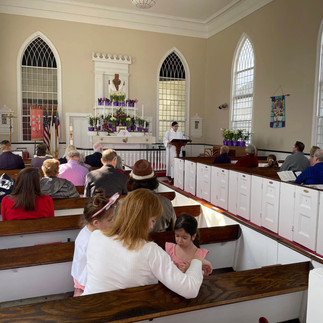The Enduring History of St. James
- St James Episcopal Church
- Jan 30
- 3 min read
Nestled in the heart of Edison, New Jersey, St. James Episcopal Church is more than just a place of worship—it’s a historical landmark with a past as rich and eventful as the very nation it calls home. From its humble beginnings in colonial America to its resilience through war, natural disasters, and societal change, St. James has stood as a beacon of faith, community, and endurance. Let’s take a journey through time to explore the incredible history of this beloved church.
The Birth of St. James Church (1704-1724)
Long before Edison became the bustling township it is today, the area was known as Piscatawaytown, a small but significant settlement dating back to the late 1600s. As religious communities took root in the New World, Anglican settlers saw the need for a dedicated place of worship. Thus, in 1704, St. James Episcopal Church was founded, making it one of the earliest churches in the region. The first church building was constructed in 1724, a simple yet sacred structure where early settlers gathered for worship, community meetings, and important events. During this period, the church was more than just a place for Sunday services—it was a cornerstone of colonial life.
A Church in the Crossfire: The Revolutionary War (1776-1777)
By the time the American Revolution broke out, St. James had already been standing for over 50 years. However, its location made it a strategic point of interest during the war. In December 1776, British troops occupied the region, and by early 1777, they had taken over St. James Church. It became a makeshift barracks and hospital for British and Hessian soldiers. The surrounding churchyard, which still exists today, was used as a campsite for British troops. Local legend suggests that wounded soldiers were treated within the church, and some of them never left—rumors of spirits haunting the grounds have circulated for generations. The war left its mark on the church and its community, but the congregation remained steadfast. Following the war, St. James was restored and continued to serve as a vital religious institution.
Devastation and Rebirth: The Tornado of 1835
As if surviving a war wasn’t enough, St. James faced yet another trial in June 1835—this time at the hands of Mother Nature. A tornado ripped through the area, completely destroying the church. However, the congregation, demonstrating immense resilience, quickly set to work rebuilding their beloved sanctuary. By 1836, a new structure was completed, ensuring that St. James would continue to serve future generations. This event cemented the church’s reputation as a symbol of endurance—able to withstand both human and natural challenges.
A Cemetery with Stories to Tell
One of the most fascinating aspects of St. James Episcopal Church is its historic churchyard cemetery. Walking through the grounds is like stepping into a living history book. Some of the oldest graves date back to the 1700s, containing the final resting places of Revolutionary War soldiers, early settlers, and notable figures from Edison’s past. Several gravestones bear inscriptions that tell tales of early colonial struggles, loss, and faith. The cemetery is a must-visit for history enthusiasts, offering a quiet but profound glimpse into the lives of those who built the community we know today.
St. James in the Modern Era
Despite the many hardships it has endured over the centuries, St. James Episcopal Church remains a thriving place of worship. The congregation continues to gather for services, celebrations, and community outreach efforts. The church has also embraced the modern age, incorporating contemporary programs while preserving its deep historical roots. Events such as historical tours, charity drives, and holiday celebrations ensure that St. James is not just a relic of the past but an active part of Edison’s present and future.
Why St. James Matters Today
St. James Episcopal Church is not just a beautiful historic site—it’s a testament to perseverance, faith, and community. Having survived wars, natural disasters, and the ever-changing landscape of America, it remains a cherished landmark in Edison, NJ.
Whether you’re a history buff, a spiritual seeker, or simply someone who appreciates a good story, St. James has something to offer. Next time you’re in the area, take a moment to visit, walk through its cemetery, admire its architecture, and reflect on the many lives that have passed through its doors. After all, very few places can say they’ve stood strong for nearly 320 years—but St. James can.
Final Thought
In a world where so much changes so quickly, places like St. James Episcopal Church remind us of the importance of history, resilience, and faith. It’s not just a building—it’s a legacy, one that will hopefully stand for centuries more to come.
So, if you ever find yourself near Woodbridge Avenue, take a detour and pay a visit to St. James Episcopal Church—a true historical gem in the heart of Edison, NJ.






